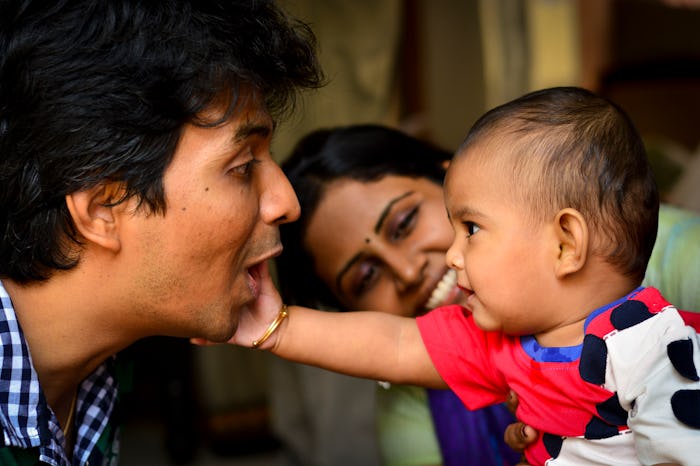Life

How To Start Teaching Your Kids About Consent, Even When They're A Baby
The other night when walking back from dinner with my grandparents, my toddler didn't want to give them a kiss goodbye. Neither my husband nor I stepped in to say that she didn’t have to. As I walked home, images of my own childhood and young adulthood flashed in front of my eyes — a little girl who never knew that she could have agency over her body. In a world where sexual assault happens at an astonishing rate, the first step we need to take to combat it is to do a better job teaching kids about consensual interactions. This applies to all children, not just young girls.
One of the reasons that I'm terrified to raise a daughter is because the world views girls' bodies as public property. The world does not respect when a girl says "no." The world does not teach girls that their body is their own. I see it as my job, as a parent, to do what I can to counteract that. Teaching kids consent has to start young, and in our house, we've had lots of discussions about how we can do it from birth.
When you teach your children, regardless of their gender, what consensual touch looks like, you can go a long way towards helping them avoid being taken advantage of — or of harming someone else. Here are seven ways you can start right away to teach your kids the value of consent, and how to practice it.
1Ask Their Permission Before Changing Their Diaper
We started this with our baby from the minute we brought her home from the hospital. Even if your kid isn’t old enough to respond, it’s a good idea to get into the habit of asking if you can undress them and explaining why you’re touching their genitals. I always told my daughter that I was making sure that she was clean, and I’d ask if I could wash her vulva in the bath (and still do.) It’s a good way to let them know know that it's their body. As they get older and more obstinate, there will be time when they say no. Respect that no, and go from there. In the case of things that may be medically necessary, like vaccines, or for their safety, like being buckle into their car seat, explaining why they have to do it is important.
2 2. Provide Anatomically Correct Language For Their Body Parts
Nicknames like “pee pee” or “hoo ha” may be cute, but the benefits end there. These terms teach children that they have body parts that they should be ashamed of or skirt around talking about. Even more importantly, it's been shown that giving children the proper names for their genitals decreases their risk of being sexually abused. And that's huge.
3Consider Waiting To Cut Their Hair or Pierce Their Ears
Their body, their choice. I don’t feel like it’s up to me to make decisions about my child’s body for her. This is also a great way to help them understand the concept of “bodily autonomy” by giving them the agency to decide what happens to it.
4Ask Them "Do You Want To" Instead of "Can You"
Instead of saying to your kid, “Can you smile and say hi to so-and-so," try asking, “Do you want to smile and say hi to so-and-so,” instead. It’s a small change that can make a big difference, and lets them know that they don’t ever have to smile for anyone and that they can do what they want with their face. Even for family members, I never want my child to feel like she owes affection to anyone.
5Never Make Them Hug Anyone If They Don’t Want To — Including You
Making your child hug or kiss a relative when they don’t want to doesn’t help them learn healthy boundaries. Particularly when children are most likely to experience sexual abuse at the hands of someone they know, forcing them to give physical affection to a relative may teach them that that person can’t be an abuser. If forcing them to hug that person is OK, then they may think that other inappropriate touching must be OK, too.
6Stop If They Say No Or Look Unhappy
Teaching your child that “no” means “no,” whether it’s their “no” or another person’s “no” starts with you respecting it when they say it. Immediately stop any tickling or playing as soon as the word "no" or "stop" is uttered. Or, if your child isn’t old enough to talk yet, if they look even remotely unhappy, stop and check in. Even before they can talk, they can do things like stick their foot out for more or lean in to show their pleasure.
7Demonstrate Consensual Touch With Your Partner(s)
Children learn a lot by modeling, and teaching consent begins with the way you interact with your partner(s). Ask each other if it’s OK to kiss before leaning in for a smooch, or ask permission before slipping a hand around their waist. Demonstrating consent goes a long way.
Images: Courtesy of mynameisharsha/Flickr; Giphy (7)